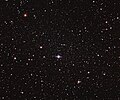Lêer:Carina Dwarf Galaxy.jpg

Grootte van hierdie voorskou: 719 × 600 piksels. Ander resolusies: 288 × 240 piksels | 576 × 480 piksels | 921 × 768 piksels | 1 228 × 1 024 piksels | 2 456 × 2 048 piksels | 3 771 × 3 145 piksels.
Oorspronklike lêer (3 771 × 3 145 piksels, lêergrootte: 5,64 MG, MIME-tipe: image/jpeg)
Lêergeskiedenis
Klik op die datum/tyd om te sien hoe die lêer destyds gelyk het.
| Datum/Tyd | Duimnael | Dimensies | Gebruiker | Opmerking | |
|---|---|---|---|---|---|
| huidig | 13:14, 24 Februarie 2015 |  | 3 771 × 3 145 (5,64 MG) | FDMS4 | Reverted to version as of 14:03, 28 June 2011. |
| 03:00, 24 Februarie 2015 |  | 3 768 × 3 144 (5,78 MG) | SteinsplitterBot | Bot: Image rotated by 180° | |
| 14:03, 28 Junie 2011 |  | 3 771 × 3 145 (5,64 MG) | Jmencisom |
Lêergebruik
Die volgende 2 bladsye gebruik dié lêer:
Globale lêergebruik
Die volgende ander wiki's gebruik hierdie lêer:
- Gebruik in ar.wikipedia.org
- Gebruik in ast.wikipedia.org
- Gebruik in ca.wikipedia.org
- Gebruik in de.wikipedia.org
- Gebruik in el.wikipedia.org
- Gebruik in en.wikipedia.org
- Gebruik in es.wikipedia.org
- Gebruik in fi.wikipedia.org
- Gebruik in fr.wikipedia.org
- Gebruik in he.wikipedia.org
- Gebruik in id.wikipedia.org
- Gebruik in it.wikipedia.org
- Gebruik in ja.wikipedia.org
- Gebruik in ko.wikipedia.org
- Gebruik in mk.wikipedia.org
- Gebruik in nl.wikipedia.org
- Gebruik in no.wikipedia.org
- Gebruik in pl.wikipedia.org
- Gebruik in pt.wikipedia.org
- Gebruik in ro.wikipedia.org
- Gebruik in ru.wikipedia.org
- Gebruik in si.wikipedia.org
- Gebruik in sk.wikipedia.org
- Gebruik in tr.wikipedia.org
- Gebruik in uk.wikipedia.org
- Gebruik in vi.wikipedia.org
- Gebruik in www.wikidata.org